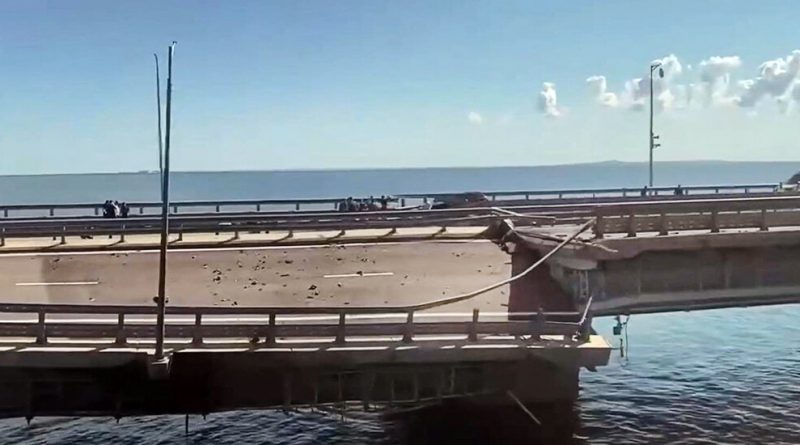Explosions Damage Crimea Bridge as Russia Blames Ukraine for Attack

Predawn explosions hit the only bridge linking the occupied Crimean Peninsula to mainland Russia on Monday, damaging a vital symbol of President Vladimir V. Putin’s claims to sovereignty over Ukrainian territory and briefly disrupting a major supply line to Russian troops.
The blasts were the second time the Kerch Strait Bridge has been hit in 10 months. And though these inflicted far less damage than an explosives-laden truck that blew up last October, they exposed the vulnerability of the bridge — and other Russian supply routes far from the front — as Ukraine wages a grueling counteroffensive to retake land.
Russia on Monday accused Ukraine of using maritime drones to assault the bridge, a strategic link for Russian forces fighting in southern Ukraine. Ukrainian officials celebrated the attack, but neither claimed nor denied responsibility for the blasts.
Hours after the attack, Moscow announced that it was pulling out of the Black Sea grain deal, an agreement that had allowed Ukraine to export its grain by sea despite Moscow’s naval blockade. Dmitri S. Peskov, the Kremlin’s spokesman, said the bridge attack was not related to Russia’s decision to suspend its participation in the deal, which had helped keep global food prices stable.
Rail service over the bridge resumed Monday morning. But damage to the car lanes, which appeared to have left part of the road tilting, according to video verified by The New York Times, threatened to constrict Russian logistical operations.
If the bridge were destroyed or severely damaged, Moscow would be left with a single major land route from Russia, along the southern coast of Ukraine, to support tens of thousands of soldiers fighting to hold onto territory captured in the first weeks of its invasion.
Mr. Putin, in a meeting with transportation officials broadcast on state TV, condemned the explosions as “another terrorist attack perpetrated by the Kyiv regime.” He said the Ministry of Defense was preparing Russia’s response and that Russia’s main security service, the F.S.B., would investigate.
“Given that this is the second terrorist attack on the Crimean bridge,” Mr. Putin said, “I am waiting for concrete proposals to improve the security of this strategically important transportation facility.”
One bridge segment was destroyed, and another was dislocated by more than 30 inches, according to Marat Khusnullin, a Russian deputy prime minister. But the main support pillars remained intact, which Mr. Putin called “good news.”
Mr. Khusnullin said limited vehicle traffic might resume as soon as Tuesday. Less damaged lanes would be restored by mid-September, and the rest of the lanes by November, he said.
Pro-war Russian military bloggers and commentators described the attack, which officials said killed two people and injured a third, as evidence of another failure by the Russian military command. Igor Girkin, a former Russian intelligence officer who runs a prominent blog, said that Ukraine would strike again and again until the bridge link is severed.
The attack came as Ukrainian forces were engaged in a grinding counteroffensive, now five weeks old, aimed at driving Russian forces from areas of southern and eastern Ukraine. Russian forces are dug in behind fields laden with land mines, so the Ukrainian military has been forced to move cautiously and progress has been slow.
Isolating Russian forces in Crimea is an essential part of the Ukrainian counteroffensive strategy, according to analysts. Ukrainian ground forces have been seeking to drive a wedge through the natural land bridge that connects Russia to the peninsula through southern Ukraine, and have repeatedly targeted the bridge, which Mr. Putin ordered built after Russia illegally annexed Crimea in 2014.
When the bridge opened in 2018, Mr. Putin hailed it as a “remarkable” achievement that strengthened Crimea. With its opening, he said, “all of us are even closer to each other.”
The explosion that hit the bridge last October was large enough to rupture fuel tanks on a passing train, setting it on fire, and pulled part of the roadway off its joints and into the sea. Ukrainian officials did not acknowledge any role until months later, but have called the 12-mile bridge a legitimate military target because of its vital logistical role in the Kremlin’s war effort.
“Any illegal structures used to deliver Russian instruments of mass murder are necessarily short-lived, regardless of the reasons for the destruction,” Mykhailo Podolyak, a senior adviser to President Volodymyr Zelensky of Ukraine, said on Twitter on Monday.
After the October attack, Moscow stepped up countermeasures to defend the structure, deploying a ship with an array of radar reflectors to protect the bridge.
A Russian agency, the National Anti-Terrorism Committee, said in a statement that Ukraine attacked the bridge on Monday with two maritime drones, a claim that could not be independently verified. Video and photographs verified by The Times showed the most significant damage along a span of the bridge heading into Russia. One photo also showed a damaged car on the bridge.
Though taking down a bridge in wartime has historically been difficult, airborne and waterborne drones may provide new ways to target the weakest points.
“Precision-guided weapons, where you can hit a specific part of the bridge, make it less difficult to knock it out,” said Samuel J. Cox, a retired rear admiral and the director of the Naval History and Heritage Command in Washington. “That allows you to get to a specific point on the bridge where you can do more damage.”
But bridge designs have improved over the years, meaning a bridge often retains the structural integrity to be repaired, instead of having to be replaced.
“I would think the Russians would be able to fix this fairly quickly,” Admiral Cox said.
Milana Mazaeva, Ivan Nechepurenko, James Glanz and Axel Boada contributed reporting.
Source – NY Times




